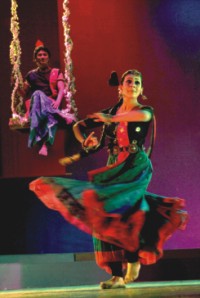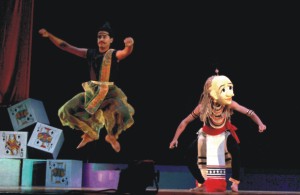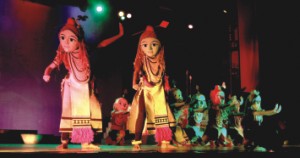| Home - Back Issues - The Team - Contact Us |
 |
| Volume 10 |Issue 17 | April 29, 2011 | |
|
|
Theatre SINGING THE NEW AANTAKI RAISA
"Khoro bayu boy bege, charidik chhay meghe…" as the timeless melody of this Rabindra Sangeet started, the magnificently decorated stage of the dance-drama, Tasher Desh, livened up with dancers in angelic white costumes. The dance form was a little unfamiliar; there was a major essence of Manipuri moves but it was not completely Manipuri either; the moves had the grace of this traditional dance form and the synergy of the contemporary. The dance did not have the classical Rabindrik touch yet the moves perfectly interpreted the lyrics of the song. The music itself sounded different in terms of the instruments played along with the song. Instead of the sole sound of Eastern classical instruments, the music flourished with some unorthodox (to Rabindra Sangeet) instruments like guitar and percussions. The age old song sounded completely new and fresh, yet containing the originality of Tagore's music. Within a few minutes, the audience received the message this drama aims to convey; the message of embracing the new. Tasher Desh (Card Country) was written by Rabindranath Tagore to criticise the society ruled by strict conventions of the British Raj; this play was written to sing the song of freshness, novelty and life without the constraints of meaningless cast and creed. This particular staging of Tasher Desh presented the heart of the story not just by enacting the screen play but also by its unique style of representation. The music, the dance, and the costumes- all spoke of moving forward and change. As part of its 'Rediscovering Tagore' festival, celebrating the 150th birth anniversary of the Nobel laureate poet, British Council presented 'Tasher Desh' at National Theatre Hall, Bangladesh Shilpakala Academy in Dhaka on April 22. The drama was produced by Shadhona-A Center for Advancement of South Asian Culture; the music was directed by the ace globe-trotting new age percussionist from Kolkata- Tanmoy Bose; the dance was choreographed by the veteran Manipuri artiste Warda Rihab, in collaboration with the head of Dance at Leeds Metropolitan University, UK, Rachel Krische.
"A major part of the young generation is not very familiar with the Rabindrik music or dance forms; our purpose was to present this popular dance-drama in a way so that anyone and everyone in the audience gets it," says the choreographer and one of the lead performers Warda Rihab. According to her, as Tasher Desh talks about change and newness, staging it in a changed and new manner would be a great idea. "We have included Manipuri bole in the music, the moves of the choreography did not embody that Rabindrik posture and expressions, still, we interpreted the drama in a modern way which was apprehensible by a broader audience. Critics might say we distorted Tagore's work but I would say we did what he did in the drama- embrace the present to move forward," she mentions. Nonetheless, the use of non-Rabindrik dance form was intelligent in terms of essence and meaning as well; for example, the choreographers used the rigid Chau dance form to enact the bounded-by-rules life of the citizens of the Tasher Desh. The name of the play in fact was 'Notun Bhabnay Tasher Desh' (Card Country in a new essence) and that's why Rihab and all the masterminds behind it tried to make it as unorthodox as possible. "To make it look completely fresh and brand new I didn't even go through any previously staging of this play and I am happy that the audience graciously enjoyed this experiment," she adds. "If the music hadn't been so contemporary, I couldn't have choreographed it in such an unconventional fashion," admits Rihab. Working with such a world class musician like Tanmoy Bose in Bangladesh was a significant experience for this dance artiste. Bose's tricky blend of Manipuri boles with contemporary instrumental in the Tagore songs inspired the choreographer to arrange the exotic scores. Tanmoy's daring attempt once again reminded the audience that the creations of Tagore are timeless, mellifluous in its own classical version and equally enchanting when fused with the contemporary.
The dance-drama had its singularity even in terms of the costume design. Designed by Neelay, Shalongkara and Shama, the costumes were a blend of classical and contemporary as well. "The lower portion, from the waist to below, the costumes were designed in a skirt-like contemporary manner; whereas the upper portion of the costumes, the inafi (Scarf in Manipuri) was designed in the classical Manipuri fashion. It was done so that the appearance of the performers matched with the essence of the dance-drama," says Rihab, who's also a part of the designing team. Representing a classic Tagore in a fusion of the present and the past was an avant-garde attempt. For the first time in Bangladesh, a Tagore play contained non-Rabindrik dance moves, the singers of the scores were not regular Rabindra Sangeet artistes. It was interesting listening to Anusheh Anadil singing Tagore's song; Shayan Chowdhury, Arnab and Rupankar Bagchi sang the songs with finesse. And as the cherry on top, there were popular Rabindra Sangeet singers like Nandita Yasmin and Lopamudra Mitra. British Council invited Rachel Krische from the UK so that she could direct the artistes with the contemporary choreography. Within a month, the crew pulled out a wonderful performance that seemed neat and well rehearsed. Shadhona and the British Council must be accredited for undertaking such an ambitious project and executing it so flawlessly! "With this drama we tried to reach a huge number of our populace who are not very familiar with Tagore or who think they do not understand Tagore. We tried to translate Tagore's artistic language with the modern language of art so that our future generation can understand the gravity of this legend's talent," says Lubna Marium General Secretary of Shadhona, who was also a performer in the dance drama. The play was indeed a great success. One does not need to read reviews or listen to the critics to know it; anyone who was at the play could experience its success by the magnitude of cheers it received during and at the end of the play. The play had its drawbacks; the sound quality could have been better. Had there been more time for contemporary choreography, its essence would have been brighter in the performances. Nevertheless, the play started a new genre of entertainment and a new era of representing Tagore to a broader audience.
Copyright
(R) thedailystar.net 2011 |


